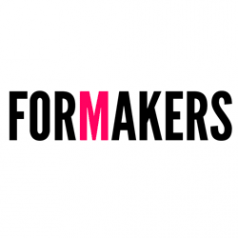27JUN 2013
 © Petr Novikov, Saša Jokić, Joris Laarman Studio Now, a large team of researchers including Petr Novikov, Saša Jokić from the Institute for Advanced Architecture of Catalonia (IAAC) and Joris Laarman Studio, have decided to up the ante.
© Petr Novikov, Saša Jokić, Joris Laarman Studio Now, a large team of researchers including Petr Novikov, Saša Jokić from the Institute for Advanced Architecture of Catalonia (IAAC) and Joris Laarman Studio, have decided to up the ante.
The result of the team’s research is Mataerial, a large robotic tool that can draw three dimensional objects that sprout vertically from the ground or horizontally from a wall, seemingly without regard to the effects of gravity.
 © Petr Novikov, Saša Jokić, Joris Laarman Studio Where traditional 3D printers print layer after layer of 2D material to build more complex shapes, Mataerial relies on a chemical reaction between two components of a thermosetting polymer to solidify almost instantly as it extrudes from a nozzle.
© Petr Novikov, Saša Jokić, Joris Laarman Studio Where traditional 3D printers print layer after layer of 2D material to build more complex shapes, Mataerial relies on a chemical reaction between two components of a thermosetting polymer to solidify almost instantly as it extrudes from a nozzle.
 © Petr Novikov, Saša Jokić, Joris Laarman Studio Perhaps the Mataerial team says it better:
One of the key innovations of anti-gravity object modelling is the use of thermosetting polymers instead of thermoplastics that are used in existing 3D printers. The material is cured because of a chemical reaction between two source components with such proportion of extrusion and movement speeds that it comes solid out of the nozzle; this feature makes it possible to print hanging curves without support material.
© Petr Novikov, Saša Jokić, Joris Laarman Studio Perhaps the Mataerial team says it better:
One of the key innovations of anti-gravity object modelling is the use of thermosetting polymers instead of thermoplastics that are used in existing 3D printers. The material is cured because of a chemical reaction between two source components with such proportion of extrusion and movement speeds that it comes solid out of the nozzle; this feature makes it possible to print hanging curves without support material.
 © Petr Novikov, Saša Jokić, Joris Laarman Studio
The device can even alter the color of the material being used to create gradients or other shifts in hue in real time.
© Petr Novikov, Saša Jokić, Joris Laarman Studio
The device can even alter the color of the material being used to create gradients or other shifts in hue in real time.
 © Petr Novikov, Saša Jokić, Joris Laarman Studio The team also proposed the creation of much larger structures such as a pavillion that could be constructed on-site with the assistance of multiple Mataerial devices.
© Petr Novikov, Saša Jokić, Joris Laarman Studio The team also proposed the creation of much larger structures such as a pavillion that could be constructed on-site with the assistance of multiple Mataerial devices.
 © Petr Novikov, Saša Jokić, Joris Laarman Studio.
© Petr Novikov, Saša Jokić, Joris Laarman Studio.
 © Petr Novikov, Saša Jokić, Joris Laarman Studio
© Petr Novikov, Saša Jokić, Joris Laarman Studio
 © Petr Novikov, Saša Jokić, Joris Laarman Studio
© Petr Novikov, Saša Jokić, Joris Laarman Studio
 on Vimeo - ©
on Vimeo - ©
 © Petr Novikov, Saša Jokić, Joris Laarman Studio
© Petr Novikov, Saša Jokić, Joris Laarman Studio
 © Petr Novikov, Saša Jokić, Joris Laarman Studio
© Petr Novikov, Saša Jokić, Joris Laarman Studio
 © Petr Novikov, Saša Jokić, Joris Laarman Studio
© Petr Novikov, Saša Jokić, Joris Laarman Studio
 © Petr Novikov, Saša Jokić, Joris Laarman Studio
© Petr Novikov, Saša Jokić, Joris Laarman Studio
 © Petr Novikov, Saša Jokić, Joris Laarman Studio
© Petr Novikov, Saša Jokić, Joris Laarman Studio
 © Petr Novikov, Saša Jokić, Joris Laarman Studio
© Petr Novikov, Saša Jokić, Joris Laarman Studio
Anti-Gravity Object Modeling: “Mataerial” Sculptures in 3D / Petr Novikov, Saša Jokić, Joris Laarman Studio
Posted in Events_Interviews - Events_Interviews by * FORMAKERS
A few months ago we saw the invention of the world’s first 3D printing pen, the 3Doodler, that allows people to draw small objects seemingly out of thin air. © Petr Novikov, Saša Jokić, Joris Laarman Studio
© Petr Novikov, Saša Jokić, Joris Laarman Studio © Petr Novikov, Saša Jokić, Joris Laarman Studio
© Petr Novikov, Saša Jokić, Joris Laarman Studio © Petr Novikov, Saša Jokić, Joris Laarman Studio
© Petr Novikov, Saša Jokić, Joris Laarman Studio © Petr Novikov, Saša Jokić, Joris Laarman Studio
© Petr Novikov, Saša Jokić, Joris Laarman Studio © Petr Novikov, Saša Jokić, Joris Laarman Studio
© Petr Novikov, Saša Jokić, Joris Laarman Studio © Petr Novikov, Saša Jokić, Joris Laarman Studio
© Petr Novikov, Saša Jokić, Joris Laarman Studio © Petr Novikov, Saša Jokić, Joris Laarman Studio
© Petr Novikov, Saša Jokić, Joris Laarman Studio © Petr Novikov, Saša Jokić, Joris Laarman Studio
© Petr Novikov, Saša Jokić, Joris Laarman Studio
 on Vimeo - ©
on Vimeo - ©
 © Petr Novikov, Saša Jokić, Joris Laarman Studio
© Petr Novikov, Saša Jokić, Joris Laarman Studio
 © Petr Novikov, Saša Jokić, Joris Laarman Studio
© Petr Novikov, Saša Jokić, Joris Laarman Studio
 © Petr Novikov, Saša Jokić, Joris Laarman Studio
© Petr Novikov, Saša Jokić, Joris Laarman Studio
 © Petr Novikov, Saša Jokić, Joris Laarman Studio
© Petr Novikov, Saša Jokić, Joris Laarman Studio
 © Petr Novikov, Saša Jokić, Joris Laarman Studio
© Petr Novikov, Saša Jokić, Joris Laarman Studio
 © Petr Novikov, Saša Jokić, Joris Laarman Studio
© Petr Novikov, Saša Jokić, Joris Laarman Studio
Comments
No comments
Sign in »



